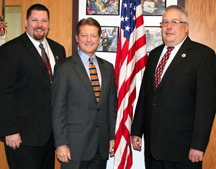Senator Gallivan visits his alma mater, Byron-Bergen CSD
 Byron-Bergen CSD Superintendent Casey Kosiorek (left) and School Business Official Bill Snyder (right) welcome New York State Senator Patrick M. Gallivan (center) to Byron-Bergen CSD, December 18.New York State Senator Patrick M. Gallivan (R-Elma) visited with students and staff at his former school district – Byron-Bergen Central School District in December.
Byron-Bergen CSD Superintendent Casey Kosiorek (left) and School Business Official Bill Snyder (right) welcome New York State Senator Patrick M. Gallivan (center) to Byron-Bergen CSD, December 18.New York State Senator Patrick M. Gallivan (R-Elma) visited with students and staff at his former school district – Byron-Bergen Central School District in December.
During the district tour, Gallivan stopped to visit Art Rohe’s U.S. History class at the Jr./Sr. High School with Superintendent Casey Kosiorek and School Business Official Bill Snyder. Students had an opportunity to ask him questions.
One question asked if the Senator had any advice for students.
“How you live your life matters, and the decisions you make today impact your life whether it’s in college or your job,” Gallivan said to the students.
Kosiorek and Snyder said their goal for Gallivan’s visit was to echo the district’s continuous efforts to advocate for all students and encourage community involvement.
“Even though our Board of Education does a very good job in providing what we have, we’re advocating to make sure our students have every opportunity they can,” Snyder said to Gallivan.
 New York State Senator Patrick M. Gallivan (center) spent some time reminiscing with Elementary Teacher Richard Merritt (right), along with Superintendent Casey Kosiorek (left), during a recent tour of Gallivan’s alma mater, December 18 at Byron-Bergen CSD. Gallivan and Merritt formerly coached basketball together at Byron-Bergen CSD.Kosiorek and Snyder showed Gallivan the closed wing of the former Middle School, which previously housed grades five and six. Currently, there are only sixth grade classrooms in operation while the fifth grade has moved to the Elementary School.
New York State Senator Patrick M. Gallivan (center) spent some time reminiscing with Elementary Teacher Richard Merritt (right), along with Superintendent Casey Kosiorek (left), during a recent tour of Gallivan’s alma mater, December 18 at Byron-Bergen CSD. Gallivan and Merritt formerly coached basketball together at Byron-Bergen CSD.Kosiorek and Snyder showed Gallivan the closed wing of the former Middle School, which previously housed grades five and six. Currently, there are only sixth grade classrooms in operation while the fifth grade has moved to the Elementary School.
Gallivan said he does understand the struggles rural school districts, like Byron-Bergen, are currently facing.
“More of our people are engaged,” Gallivan said. “We also continue to advocate and campaign.”
Some of the district’s improvements were also highlighted during the tour, from its recent Capital Project in 2010, including the new Jr./Sr. High School cafeteria.
“Everything for our community is right here (showing the new kitchen and cafeteria space),” Snyder said to Gallivan. “Our new cafeteria is in close proximity to the auditorium and gymnasium for school and community events.
“This visit also provided us the opportunity to discuss future steps that the legislature could take to confront the inequitable distribution of state aid,” Kosiorek said. “This is so important for districts like ours that depends so greatly on this funding.”




